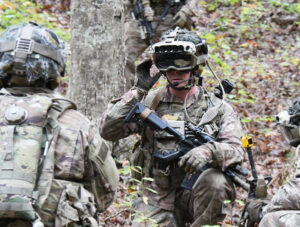The Army’s updated plan for its new Integrated Visual Augmentation System (IVAS) headset includes rolling out a small number of initial headsets next while developing a “1.2” version of the capability that incorporates additional design improvements, the service’s top acquisition official said Monday.
Doug Bush, assistant secretary of the Army for acquisition, logistics and technology, said this summer’s initial operational test and evaluation (IOT&E) for IVAS highlighted further work required on the capability related to software stability, low-light performance and form factor of the headset.

“Our path to doing that is going fielding a relatively small number of, we’re calling them, 1.0 and 1.1 systems, both improvements, particularly 1.1. And then also doing the research and development work on 1.2 which is, at this point, our objective system,” Bush said during a Defense News panel at the Association of the United States Army’s annual conference in Washington, D.C.
The updated IVAS rollout plan, first reported by Military Times, follows the Army’s decision last year to push back the program’s timeline, to include delaying IOT&E from its original late FY ‘21 start date to allow time for further enhancements to the capability.
“We have the flexibility to change our plan because we’re in rapid fielding. If we were in a traditional milestone-based program, we would be in a two-year cycle and have to go back to [Office of the Secretary of Defense] to get approval to change the plan. We have flexibility. OSD, they’re letting us use it. We’re working closely with Congress so they understand our plan. This is a different way of doing things,” Bush said on Monday.
Last March, the Army awarded Microsoft [MSFT] a deal worth up to $21.9 billion over the next 10 years to move the IVAS augmented reality headset program from rapid prototyping into production (Defense Daily, March 31 2021).
“[IVAS] is a good example of a program that was on a very rapid path. Unsurprisingly, we ran into some technology challenges. But we have a way to fix them and a way to go forward,” Bush said.